Abstract
Acanthamoeba keratitis (AK) is a potentially blinding infection caused by protozoa found worldwide. The topical application of biguanides and diamidines is the most common anti-amoebic treatment for AK. In this study, we hypothesized that geographical location and socioeconomic status influence the management and treatment of AK. To test this hypothesis, we analyzed case reports and series of Acanthamoeba eye infections from different geographic regions to evaluate the association between diagnosis, treatment, and outcome worldwide. This study looked specifically at case reports of patients with diagnosed AK using bibliographic databases such as PubMed, BioMed Central, and Google Scholar, which were searched between 30 April 1990 and 1 May 2022. The search identified 38 eligible studies that provided data for 60 clinical cases of AK. The results indicated that current standard treatments are effective if the infection is identified early and that delays can lead to clinical symptoms, including permanent visual opacities. There was evidence suggesting an association between the treatment regimen practiced in certain geographic regions and treatment outcome. Patient access to medical facilities and economic background also had an influence on the treatment and outcome of AK. Further analysis of more case reports can expand our understanding of the influence of specific demographic and individual patient characteristics on the effectiveness and accessibility of AK medicines. Additionally, using a living systematic review approach to incorporate emerging evidence will reveal the relative merits of different treatment regimens for AK and outcomes.
1. Introduction
Acanthamoeba spp. are single-celled free-living amoebae found in almost all terrestrial biomes, hot springs in the Antarctic, estuaries, beaches, ocean sediment, dust, air, and both fresh and saltwater ecosystems, as well as sewage and aquaria [1,2,3,4]. Transmission between humans has not yet been reported; however, there have been many incidences of infection in different animal species with potential impact on public health [5]. Acanthamoeba spp. can cause three main conditions: a disseminated infection, an infection of the brain and spinal cord known as granulomatous amoebic encephalitis (GAE), and Acanthamoeba keratitis (AK). Both GAE and disseminated infection are more prevalent in immunocompromised patients [6], whilst AK more commonly involves poor hygienic practices when using contact lenses [7,8], such as poor hand hygiene before handling contact lenses [9], non-adherence to rules labeled on packaging regarding storage, hygiene, disposal of lenses, frequency of contact lens replacement [10], swimming or showering while wearing contact lenses [11], and using tap water to clean contact lenses or storage cases [12]. All three clinical conditions can be life-altering, with the disseminated infection being fatal in about 85% of cases [13] and GAE being fatal in almost all cases if not timely diagnosed [14]. Although AK is not fatal, it is potentially blinding.
Diagnosis of AK relies on the timely recognition of clinical symptoms. The most common symptoms of AK include, but are not limited to, ocular pain, tearing, redness, photophobia, blurred vision, opacity/stromal infiltrate, edema, vision loss, hypopyon, ring infiltrate, and neovascularization of the cornea [15]. Diagnosis of AK is not straightforward and is often misidentified as other more prevalent conditions, including mycotic, herpetic, or bacterial keratitis rather than Acanthamoeba [16]. This limited ability to efficiently identify ocular infections can lead to deterioration of symptoms [17]. Diagnostic techniques for AK include confocal microscopy combined with corneal scrapings, which are used to make smears for direct microscopic examination and to culture on non-nutrient agar (NNA) plates seeded with a lawn of Escherichia coli for detection of the amoeba [18,19,20,21]. Polymerase chain reaction (PCR) and real-time PCR assays have a much higher sensitivity compared to microscopic examination and culture for detecting Acanthamoeba in ocular samples, particularly when a combination of different PCR assays is used [22].
Treatment of AK involves a combination of biguanides such as polyhexamethylene-biguanide (PHMB) and diamidines, such as hexamidine diisethionate, dibromopropamidine, and propamidine isethionate, which are normally used at concentrations of 0.02% (biguanides) and 0.1% (diamidines), respectively [23,24]. Antibiotics such as neomycin disrupt Acanthamoeba food sources, providing a path to reduce infection [23]. Antifungals such as clotrimazole, voriconazole, and miconazole have also been used to treat Acanthamoeba infection [23]. Conservative treatments are ideal, but surgery is occasionally required; techniques such as penetrating keratoplasty (PK), amniotic membrane transplant (AMT), or corneal cryotherapy are used [22]. Treatment often involves topical steroids to reduce the discomfort and limit corneal vascularization [25], as well as reduce inflammation [26]. However, the use of steroids can be associated with undesirable side effects, such as poor treatment outcomes, allergic reactions, cataract formation, and increased infection susceptibility [27,28]; the latter can be worse in Acanthamoeba infected patients who are immunosuppressed.
A better understanding of which groups of people are at a higher risk of Acanthamoeba infection is important to prevent AK. Evidence suggests that contact lens wearers have a higher risk of developing AK [29]. The constant increase in the global population adds to the number of contact lens wearers, which has been identified as a leading contributor to contact with pathogens, including Acanthamoeba [30]. Contact lenses can act as a vector for Acanthamoeba residing on the posterior surface of the lens, allowing direct contact with corneal cells. These amoebae would normally be removed through blinking and tears, but this is hindered when wearing lenses [31]. The global annual incidence of AK varies greatly from 17–70 cases per million contact lens wearers [32]. Acanthamoeba infection can also occur in non-contact lens wearers [3,33] and is largely mediated by direct contact with contaminated water and corneal injury [34]. The worldwide population of immunosuppressed/compromised patients has increased and continues to rise significantly [35]. Additionally, the number of organ transplants and cancer patients undergoing therapy in developed countries has led to increased use of immunosuppressant drugs, which add additional risk for developing keratitis. A malnutrition-related weakened immune system and untreated congenital or acquired disorders are key components involved in protozoan infection in developing nations [36], including Acanthamoeba.
Geopolitical awareness and understanding the reality that certain populations have no other choice but to drink, bathe in, and use untreated water [37] is important in dictating why known risks are still encountered. Evidence points to massive implications involving the consumption of poorly treated water with elevated risks of coming into contact with protozoan parasites such as Acanthamoeba spp. [38]. Touching the eyes with wet hands containing Acanthamoeba can cause AK. Water hardness has been correlated with an increased risk of contracting AK [39], and groundwater hardness is prevalent worldwide, especially in regions without adequate water filtration systems. Taking this into account and understanding that developing nations may not receive adequate healthcare could signify that infection numbers are larger than currently observed. Cases may go underreported in countries without universal healthcare due to accessibility issues, leaving keratitis untreated. Control of Acanthamoeba and other protozoan parasites for developing nations relies mostly on access to clean water. Populations living in countries undergoing conflict are at even higher risk of infection due to increased infrastructure damage. In addition, risk management under these circumstances is limited to projects and charities providing clean water sources. This emphasizes the importance for ophthalmologists to continue educating patients about the possible sources of Acanthamoeba and the importance of good personal hygiene practices to control infection [40].
Large-scale analysis of AK patient data reported in case reports from different geographical regions can help develop an understanding of the risk factors to look for in terms of Acanthamoeba infection. This information could be utilized to educate at-risk patients about how they could reduce the risk of infection. A geographical analysis of how cases occur, diagnosis of infection, treatment given, and outcome for different countries/continents would be beneficial in understanding how different management regimens practiced in individual countries can influence the treatment outcome of AK. Hence, we conducted this study to gain more insight into current management and treatment options for AK and to identify how these may differ depending on geographical regions. We also reviewed the literature and case reports to identify factors involving the clinical history and symptoms and to note the most common methods of AK diagnosis.
2. Results
2.1. Literature Search Results
As shown in Figure 1, 874 abstracts were identified as potentially relevant for inclusion in the study from all databases searched (PubMed, 126; BioMed Central, 59; Google Scholar, 689). Screening through the title and abstracts while applying exclusion criteria (e.g., reports on veterinary cases, non-parasitic keratitis, other forms of infection [e.g., GAE or disseminated infection], lack of relevant information on individual patient history, clinical signs, diagnosis, treatment, or outcome) led to 24 papers being identified from Google Scholar. From PubMed, 32 papers were obtained, which were narrowed down to 12. Two case reports were gathered from BioMed Central. Duplicates were deleted using EndNote. We attempted to gather a representative sample of papers for each geographical region. This was made difficult by the lack of case reports with the desired inclusion criteria for Africa and South America, with only seven and three reports found, respectively. Initially, results were categorized into six groups, representing the relevant case reports through a strictly continental approach; however, six case reports were found from the Middle East, and this was added as an extra category as a subsection of Asia.
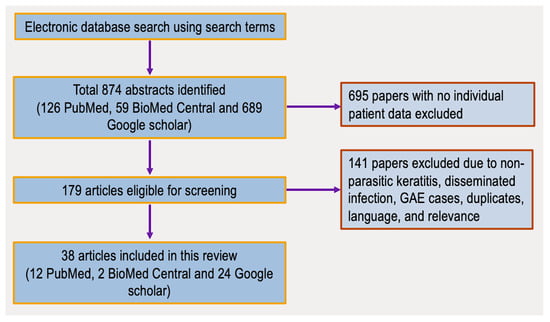
Figure 1.
Flow chart showing selection process of relevant studies reporting individual patient data.
2.2. Summary of AK Cases Reported Worldwide
The review identified 38 eligible case reports that provided individual patient data for 60 patients (mean age [M] 34.1 years, standard deviation [S.D.] = 15.1, the gender ratio was 11:19 male to female, 22 males (36.6%), 38 females (63.3%) (Figure A1). The global geographical distribution of all reported AK cases is shown in Figure 2. The largest number of cases was reported from North America (n = 13), followed by Asia (n = 11), Europe (n = 10), Australasia (n = 10), Africa (n = 7), and Middle East (n = 6), and the lowest number of cases was reported from South America (n = 3).
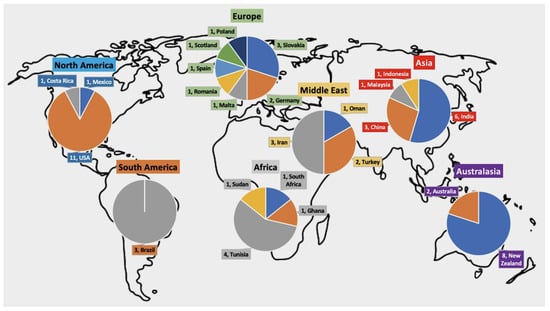
Figure 2.
Global distribution of the identified AK cases by continent.
2.2.1. Clinical History and Symptoms
In all geographical regions, hygiene issues regarding contact lens care and use were the most prevalent risk factor leading to AK; this included swimming with lenses, sharing lenses between people, and reusing old lenses. Access to treated water is important, as many cases developed from rinsing lenses in tap water. Another common patient history included working-class patients (manual laborers and fishermen) getting organic materials or water in their eyes during work and developing infections, which was most notable in the Asiatic region. Information about previous infection or misdiagnosis was observed throughout all regions, with initial diagnosis often misidentified as more frequent conditions such as bacterial, fungal, or viral keratitis. Most cases were not initially identified as Acanthamoeba-related, and positive diagnosis only occurred after ineffective treatment or progression of symptoms. Figure 3 summarizes the clinical symptoms extracted from all reports included in this review.
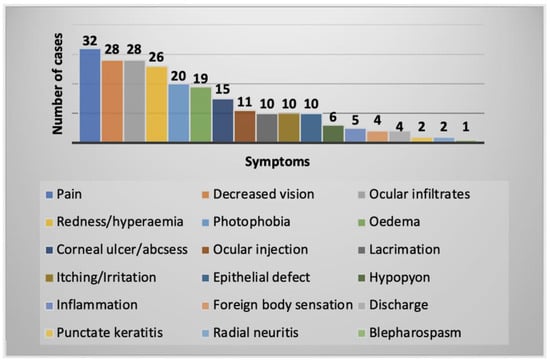
Figure 3.
The frequency of clinical symptoms reported from all AK cases. Decreased vision included blurry vision, decreased visual acuity, and loss of vision. Ocular infiltrates included corneal, stromal, and other precipitates.
2.2.2. Diagnostic Methods Used
From a global perspective, culture was the most utilized diagnostic method. Figure 4 identifies all the diagnostic methods reported to have been utilized from individual patient data. Combined diagnostic testing occurred in 42% (25/60) of identified cases.
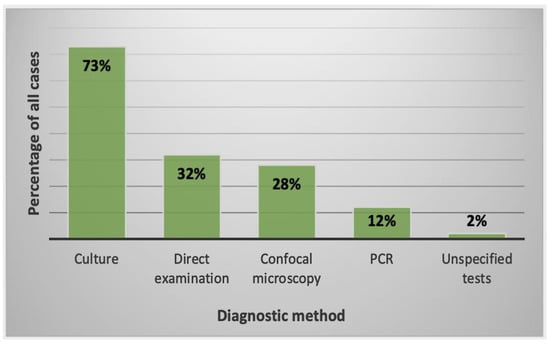
Figure 4.
The representation of the diagnostic methods used to confirm AK worldwide.
2.2.3. Alternative Treatment Methods
For cases where drug therapy proved ineffective or ocular damage was irreparable, PK, AMT, deep anterior lamellar keratoplasty (DALK), intraocular lens insertion, or corneal transplants were performed. Approximately 42% (25/60) of identified cases required surgery. The number of surgeries is represented in Figure 5. The non-surgical treatment approaches are shown in Figure 6. Prednisolone was used in the management of five cases from Australasia and one case from Europe.
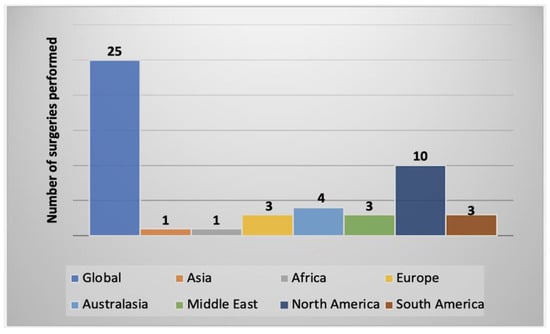
Figure 5.
Global and regional proportions of surgeries performed in cases of AK, including Asia (9%; 1/11), Africa (14%; 1/7), Europe (30%; 3/10), Australasia (40%; 4/10), Middle East (50%; 3/6), North America (77%; 10/13), and South America (100%; 3/3).
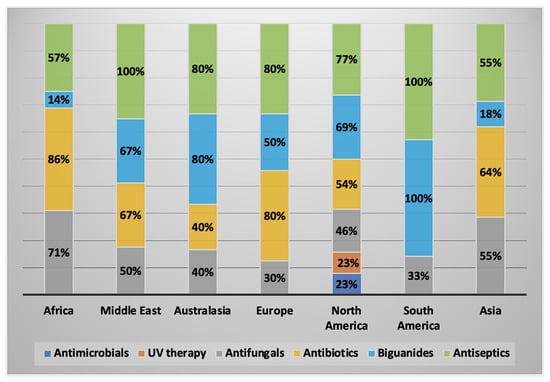
Figure 6.
Proportions of the non-surgical treatment utilized for all AK cases by geographical region.
2.3. Characteristics of AK Cases by Geographical Regions
2.3.1. AK Cases in Africa
A total of seven cases were reported from Africa. The age range of AK patients was 17–55 years old (M = 29.14, S.D. = 12.41). Contact lenses were utilized in five cases (71%). The most common diagnostic method used was culture, utilized in five cases (71%). Combined diagnostic efforts were used in three cases (43%). There was one case series with three cases reported. Combined drug therapy was used in six cases (86%). The percentages of drugs used in the treatment of AK are shown in Figure 7. Additional information about the management of AK in Africa is presented in Table A1. The outcome of all cases showed general improvement of clinical signs with no recurrence of the infection. Remaining corneal opacities or decreased visual acuity were present in five cases (71%).
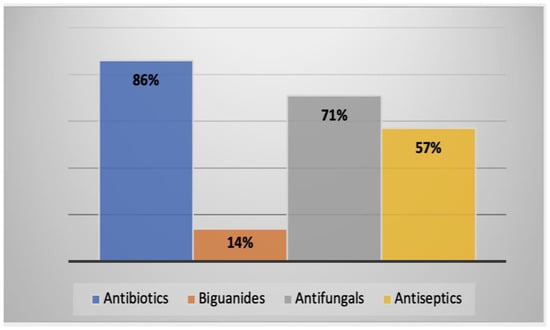
Figure 7.
The percentages of drug classes used for treatment of AK patients in Africa. Antibiotics were used in 86% of identified cases (neomycin (4), gentamicin (2), vancomycin (2), cefotaxime-fosfomycin (1), chloramphenicol (1)). Biguanides were used in 14% of identified cases (PHMB (1)). Antifungals were used in 71% of identified cases (econazole (1), amphotericin B (1), ketoconazole (2), fluconazole (1)). Antiseptics were used in 57% of identified cases (hexamidine (4), chlorhexidine (1)).
2.3.2. AK Cases in the Middle East
A total of six cases were reported from the Middle East. The age range of AK patients was 5–44 years old (M = 29.67, S.D. = 13.81). Contact lenses were utilized in four (66.7%) of the cases. The most common diagnostic method used was confocal microscopy, utilized in four (66.7%) cases. Combined diagnostic efforts were used in three (50%) cases. There was one case series involving two cases. The percentages of drugs used in the treatment of AK are shown in Figure 8. Additional information about the management of AK is presented in Table A2. Combined drug therapy was used in six (100%) of the cases. Deterioration of cases with subsequent improvement after undergoing PK was detected in two cases (33%). Another two (33%) of the cases showed gradual improvement with remaining clinical symptoms, including corneal opacity and decreased visual acuity. Complete recovery with no visual loss occurred in one case (17%), and one case (17%) did not have a clear outcome. In case 1 (Table A2), medicine was not available in that specific region and had to be ordered, delaying treatment. In case 3 (Table A2) original Acanthamoeba treatment was not successful and thus required altering the therapeutic regimen used.
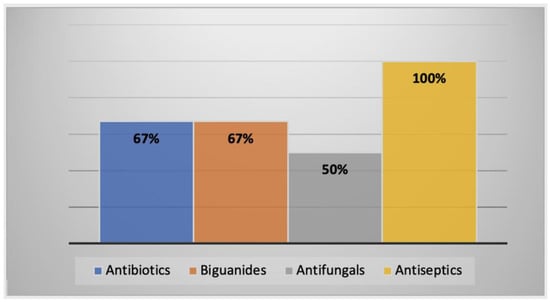
Figure 8.
The percentages of drug classes used for the treatment of AK patients in the Middle East. Antibiotics were used in 67% of identified cases (neomycin (1), vancomycin (1), moxifloxacin (2), polymyxin B (1), ceftazidime (1)). Biguanides were used in 67% of identified cases (PHMB (4)). Antifungals were used in 50% of identified cases (ketoconazole (1), fluconazole (1), itraconazole (1)). Antiseptics were used in 100% of identified cases (chlorhexidine (3), propamidine isethionate (4)).
2.3.3. AK Cases in Australasia
A total of 10 cases were reported from Australasia. The age range of AK patients was 17–50 years (M = 34.3, S.D. = 10.36). Contact lenses were utilized in 10 cases (100%). The most common diagnostic method used was culture, utilized in nine (90%) of the cases. Combined diagnostic efforts were used in two cases (20%). There was one case series involving seven cases. The percentages of drugs used in the treatment of AK are shown in Figure 9. Additional information about the management of AK is presented in Table A3. Combined drug therapy was used in nine cases (90%). Certain initial standard treatment options appeared to be ineffective in over half of the cases (see Table A3). Out of the reported cases, three cases (30%) underwent PK, and two cases (20%) underwent epithelial debridement as symptoms worsened. Optic atrophy was attributed to potential neurotoxicity from overuse of medication (see case 4). In case 6, PHMB resistance was noted, and therapy was adjusted.
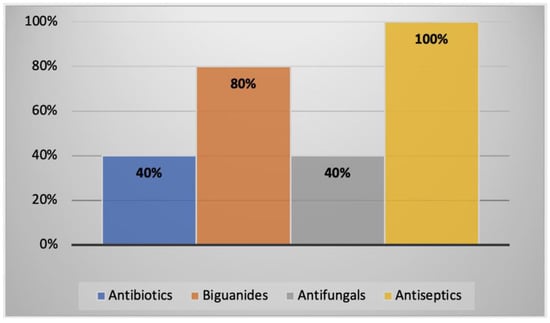
Figure 9.
The percentages of drug classes used for the treatment of AK patients in Australasia. Antibiotics were used in 40% of identified cases (neomycin (3), polymyxin B (3), bacitracin (3), gentamicin (1), cephalothin (1)). Biguanides were used in 80% of cases of identified cases (PHMB (8)). Antifungals were used in 40% of identified cases (itraconazole (4), miconazole (4)). Antiseptics were used in 80% of identified cases (propamidine isethionate (8), chlorhexidine (2)).
2.3.4. AK Cases in Europe
A total of 10 cases were reported from Europe. The age range of AK patients was 9–73 (M = 36.1, S.D. = 20.84). Contact lenses were utilized in eight cases (80%). The most common diagnostic method used was culture, utilized in eight cases (80%). Combined diagnostic efforts were used in four cases (40%). Four cases came from two case series, each with two cases. The percentages of drugs used in the treatment of AK are shown in Figure 10. Additional information about the management of AK is presented in Table A4. Combined drug therapy was used in 10 cases (100%). Of all cases reported, two cases (20%) underwent PK, with one case requiring enucleation. Corneal transplant occurred in one case (10%). Seven cases (70%) showed amelioration through drug therapy without surgical intervention showing improvement in visual acuity, with some cases reporting scarring and corneal opacities. In two (20%) of the cases, the required medication was not on hand, delaying treatment.
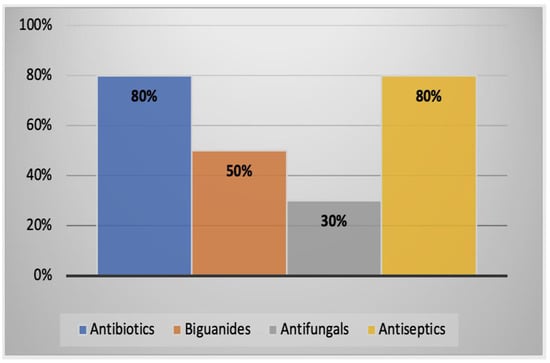
Figure 10.
The percentages of drug classes used for the treatment of AK in Europe. Antibiotics were used in 80% of identified cases (neomycin (5), polymyxin B (3), gramicidin (2), azithromycin dihydrate (1), cefazolin (1), ciprofloxacin (1), ofloxacin (1)). Antifungals were used in 30% of identified cases (itraconazole (2), ketoconazole (1)). Biguanides were used in 50% of identified cases (PHMB (5)). Antiseptics were used in 80% of identified cases (propamidine isethionate (8), chlorhexidine (2)).
2.3.5. AK Cases in North America
A total of 13 cases were reported from North America. The age range of AK patients was 18–71 (M = 44.1, S.D. = 15.03). Contact lenses were utilized in 13 (100%) of the cases. The most common diagnostic method used was culture, utilized in nine cases (69%). Combined diagnostic efforts were used in six (46%) of the cases. Four case series included three, two, two, and three cases, respectively. The percentages of drugs used in the treatment of AK are shown in Figure 11. Additional information about the management of AK is presented in Table A5. Combined drug therapy was used in 13 (100%) of the cases. Seven cases (54%) underwent PK or DALK, two cases (15%) underwent corneal debridement, and one case (7%) received AMT. Out of all patients, three cases (23%) improved with drug therapy without additional therapy. UV therapy was used in three cases (23%) where standard treatment was found to be ineffective.
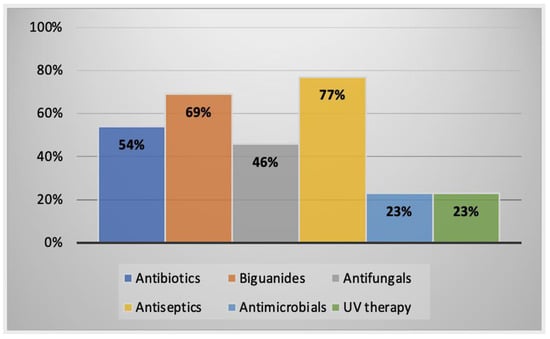
Figure 11.
The percentages of drug classes used for the treatment of AK in North America. Antibiotics were used in 54% of identified cases (netilmicin (1), polymyxin B (1), besifloxacin (1), moxifloxacin (3), sulfamethoxazole (2), trimethoprim (2), ofloxacin (1), tobramycin (1)). Antifungals were used in 46% of identified cases (itraconazole (1), fluconazole (1), voriconazole (5)). Biguanides were used in 69% of identified cases (PHMB (9)). Antiseptics were used in 77% of identified cases (propamidine isethionate (3), hexamidine (1), chlorhexidine (9), pentamidine (1)). Antimicrobials were used in 23% of identified cases (miltefosine (3)). UV therapy was used in 23% of identified cases (UVA and B2 (3)).
2.3.6. AK Cases in South America
Three cases were reported from South America. The age range of AK patients was 19–28 (M = 24.33, S.D. = 4.93). Contact lenses were utilized in three cases (100%). The most common diagnostic methods used were culture and PCR, both being utilized in two cases (66.7%). Combined diagnostic efforts were used in two cases (66.7%). All the cases were derived from individual reports (i.e., no case series). The percentages of drugs used in the treatment of AK are shown in Figure 12. Additional information about the management of AK is presented in Table A6. Combined drug therapy was used in three (100%) of the cases. Out of all cases, one case (33%) underwent PK, and the other two cases (66%) underwent corneal transplants. No recurrence and general improvement after surgeries for cases 2 and 3. Case 1 underwent complications and was lost to follow-up.
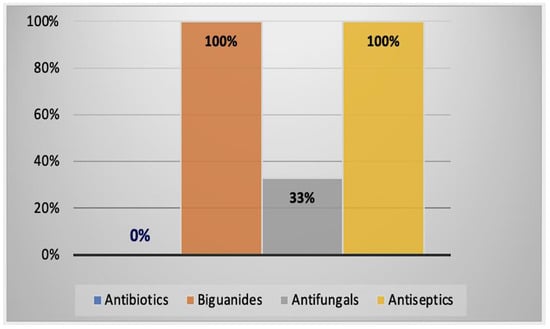
Figure 12.
The percentages of drug classes used for the treatment of AK in South America. No recorded use of antibiotics from cases identified. Biguanides were used in 100% of identified cases (PHMB (3)). Antifungals were used in 33% of identified cases (ketoconazole (1)). Antiseptics were used in 100% of identified cases (propamidine isethionate (3), chlorhexidine (1)).
2.3.7. AK Cases in Asia
A total of 11 cases were reported from Asia. The age range of AK patients was 9–47 (M = 28.27, S.D. = 13.07). Contact lenses were utilized in six cases (55%). The most common diagnostic method used was culture, utilized in eight cases (73%). Combined diagnostic efforts were used in five cases (45%). Two case series included two and four cases, respectively. The percentages of drugs used in the treatment of AK are shown in Figure 13. Additional information about the management of AK is presented in Table A7. Combined drug therapy was used in 11 cases (100%). Out of the cases reported, six (55%) of identified cases showed improvement without surgical intervention. Case 2 was advised PK but refused, leading to a deterioration of symptoms. One case received AMT. Two cases were lost to follow-up.
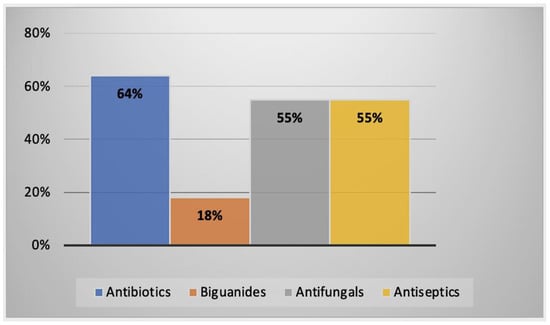
Figure 13.
The percentages of drug classes used for the treatment of AK in Asia. Antibiotics were used in 64% of identified cases (neomycin (7), polymyxin B (7), bacitracin (6), gramicidin (1), gentamicin (1)). Antifungals were used in 55% of identified cases (miconazole (3), metronidazole (3), ketoconazole (3)). Biguanides were used in 18% of identified cases (PHMB (2)). Antiseptics were used in 55% of identified cases (propamidine isethionate (3), chlorhexidine (3)).
3. Discussion
We assessed current evidence regarding whether different geographic regions with varying socioeconomic resources have different treatment outcomes of AK based on the type of treatment intervention. AK causes grave consequences for those infected, and certain populations are at higher risk, specifically for those unable to receive prompt treatment [17]. Looking at all 60 identified AK cases gathered in this review, 49 cases (81.67%) (Figure A2) were confirmed contact lens wearers, highlighting a higher prevalence of infection for those utilizing lenses, which is a risk factor that has been frequently identified [29,30,31]. Other research indicates that contact lens use may not be as significant as previously thought [33].
Findings from this review showed infections were prevalent in all age groups with seemingly no correlation between age and infection; however, other research has identified some associations [31]. It was found that many cases had concurrent infections or pre-existing conditions, which affected how rapidly treatment was administered. Patients suffered for longer when misdiagnosed, and outcomes were less favorable [16,17]. Combined drug treatment was used in 97% of identified cases (Figure A3), highlighting how the current treatment procedure involves the use of many different drugs with no globally standardized therapeutic plan. UVA and B2 therapy were reported as potentially effective treatments [41]. A total of 8% of the cases had issues with obtaining drugs due to location or lack of knowledge about Acanthamoeba, leading to an unprepared treatment approach.
It should be noted that the results presented in this paper are not conclusive; however, the study findings have implications for clinicians and researchers. The three most significant clinical symptoms reported in AK cases that clinicians should recognize are pain, decreased vision, and ocular infiltrates (Figure 3). The initial misdiagnosis issues could be attributed to how uncommon AK is, thus leading to longer response times for administering treatment. Misdiagnosis was common in all regions, with AK mostly initially diagnosed as herpetic keratitis [42]; research shows that coinfection can also occur [43]. Culture using NNA seeded with E. coli was universally and regionally identified as the most utilized diagnostic tool and was present in 73% of all cases reported (Figure 4). Cultures are currently regarded as the “gold standard” [44], but sensitivity is often limited. Contamination of culture occurred in 5% of the cases, signifying the reason why multiple diagnostic tests should be performed. The proportions of the diagnostic tests used in all AK cases are shown in Figure A4. The current surgical options that were most utilized were PK or corneal transplants, with generally good outcomes (Figure 5).
To our knowledge, there are few reviews using individual patient data reported in case reports to consider the associations of population and geographic factors with treatment outcomes across different treatment regimens of AK. However, case reports are often not standardized in terms of the information they contain, hindering deeper analysis and direct comparisons. Also, papers in languages apart from English and French were excluded, leading to potential bias in terms of reviewing case reports. Papers with more than one clinical case were noted as having an increased bias as most cases would have been treated in the same or similar manner.
4. Materials and Methods
4.1. Identification and Selection of Studies
In this review, the online bibliographic databases PubMed, BioMed Central, and Google Scholar were searched from 30 April 1990 to 1 May 2022. The following search terms were used: Acanthamoeba, Acanthamoeba keratitis, AK, case report(s), amoebic keratitis. Papers were limited to English and French.
4.2. Eligibility Criteria
Inclusion criteria included studies on clinical cases of AK from different regions around the world. Studies were excluded if they reported on veterinary cases, other forms of infection (e.g., GAE or disseminated infection), or if they lacked information on patient history, clinical signs, diagnosis, treatment, or outcome. Papers were also eligible if they contained more than one case report and included the above information but excluded if they did not show individual treatment and outcome. Studies involving “possible” cases of AK were excluded if not diagnosed as Acanthamoeba-related via confocal microscopy, culture, PCR, or other specified methods. Papers with concurrent diseases were included if there was a diagnosis, treatment, and outcome of AK.
4.3. Information Sources
One researcher reviewed all publications included in this review, screening through relevant abstracts until the paper was deemed eligible for the review. The full text was then read and analyzed, with the data being placed into different tables. An objective was made to gain a sample of papers for each geographic region to gather evidence to either support or disprove the hypothesis.
4.4. Data Charting Process
Data were extracted from each case report and key information, including year of publication, patient age, gender, wearing contact lenses, clinical symptoms, how Acanthamoeba was diagnosed, how Acanthamoeba was treated, and outcomes were all tabulated. The information gathered was specifically related to Acanthamoeba and not towards treatment or outcome of any other concurrent conditions to ensure that only information relevant to AK management was recorded. Extracted information was condensed into a more legible format, and data in the table was ordered from oldest to newest.
The diagnostic approaches recorded in the table were simplified to culture, direct examination, PCR, and confocal microscopy. The unspecified tests were also noted. Culture involved using NNA seeded with E. coli. Different types of culture media were utilized in some cases, but the majority was NNA. Direct examination involved directly looking at corneal scrapings, contact lenses, lens storage cases, and lens fluid under a microscope or using a slit lamp to examine the eye. PCR involved DNA amplification in identifying infection as Acanthamoeba. Confocal microscopy involved using a microscope as a non-invasive technique to observe and analyze ocular tissue.
5. Conclusions
The findings of this review of individual patient data suggest that there are differences when it comes to medical approaches for the treatment of AK. These can be linked to medical resources available, remoteness of patients, and higher exposure to parasites due to labor or lifestyles. In several cases, specific medications or diagnostic methods were not accessible in the regions that patients inhabited. This meant that either medication had to be ordered, delaying treatment, or patients attempted to seek treatment abroad, with this issue being identified in both developed and developing nations. It was also noted that diagnosis became limited when there was a lack of NNA seeded with E. coli because this method can confirm the presence of Acanthamoeba. A combined diagnostic approach should be utilized in all suspected cases of AK. Awareness of economic advantages in developed countries and how these can affect treatment outcomes are shown in the cases of North America. These cases often received surgery if treatment was ineffective due to facilities being more readily available compared to developing nations. Furthermore, countries may follow different legislations about novel treatments and alternate drug regulations, dictating what medication is available. Evidence suggests that antiseptics were the most utilized treatment, but it is the combination of drug use that appears to be the solution, possibly because no single drug has yet been developed to successfully eradicate Acanthamoeba infection. However, combinations vary by region, potentially affecting efficacy and outcome for cases. Taken together, these findings indicate that geographical location has an impact on the availability of adequate treatment and associated outcomes.
Author Contributions
Conceptualization, H.M.E.; methodology, M.B. and H.M.E.; investigation, M.B.; resources, M.B. and H.M.E.; data curation, M.B.; writing—original draft preparation, M.B.; writing—review and editing, H.M.E.; visualization, M.B. and H.M.E.; supervision, H.M.E.; project administration, H.M.E. All authors have read and agreed to the published version of the manuscript.
Funding
This research received no external funding.
Institutional Review Board Statement
The study was conducted with the approval of Nottingham University, School of Veterinary Medicine and Science Committee for Animal Research and Ethics (Approval No. 3590 220428).
Informed Consent Statement
Not applicable.
Data Availability Statement
Not applicable.
Conflicts of Interest
The authors declare no conflict of interest.
Appendix A
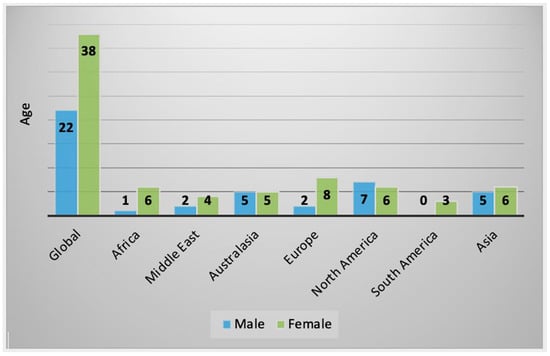
Figure A1.
Gender ratio of all AK cases reported regionally and globally.
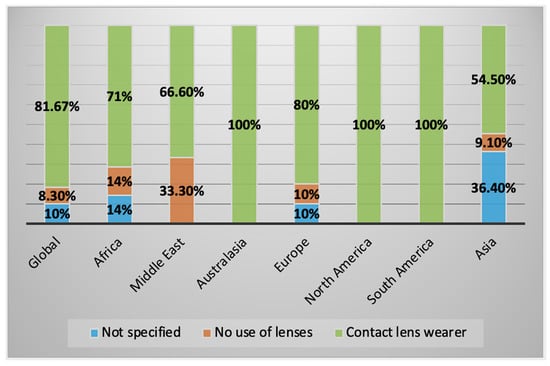
Figure A2.
Global and regional percentages of infected patients who wore contact lenses, wore no lenses, or had no specified lens use.
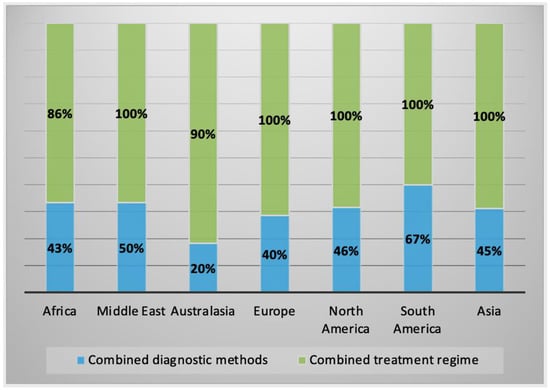
Figure A3.
Percentages of all cases utilizing combined diagnostic methods and combined treatment regimens.
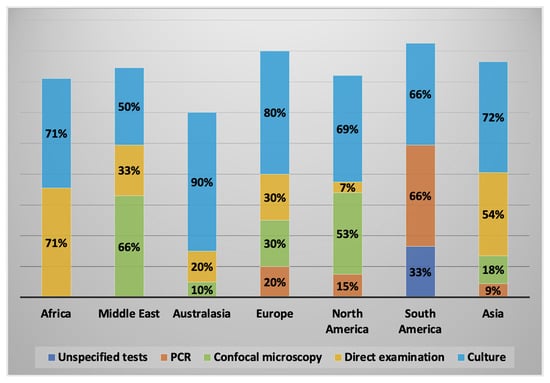
Figure A4.
Percentages of different diagnostic tests utilized across different geographic regions.
Appendix B

Table A1.
Summary of the management of AK clinical cases in Africa.
Table A1.
Summary of the management of AK clinical cases in Africa.
| Case No. | Country | Age | Sex | Eye Involved | Contact Lens Wearer | Diagnostic Method(s) | Therapeutic Regimen | Outcome of Treatment | Reference |
|---|---|---|---|---|---|---|---|---|---|
| 1 | South Africa | 31 | F | Right | Yes | Culture and direct examination | Topical neomycin and 0.02% PHMB drops q1h continued for 12 months. | Improvement of symptoms following treatment, but best visual acuity was limited to counting fingers. No noted recurrence. | [45] |
| 2 | Ghana | 25 | M | Unknown | No | Direct examination | Chloramphenicol, gentamicin, and Econazole; no dose specified. | Improvement of symptoms with scar formation after 21 days; visual acuity was hand movements only. Patient lost before final visit. | [46] |
| 3 | Tunisia | 27 | F | Left | Yes | Culture and direct examination | Nizoral® 1 tab BID. Fungizone® ED 6× per day. Sophtal® 6× per day. Vancomycin-Fortum® and Desomedine® ED q1h for 2 days, then spaced out for 3 weeks. Desomedine® continued for 4 months. | Improvement of symptoms with good visual acuity. No noted recurrence. | [47] |
| 4 | Sudan | 55 | F | Left | Unknown | Culture | Oral ketoconazole 200 mg BID for 2 months. Topical saline 0.9%. | Symptoms improved; cornea scarred with remaining vision loss. No noted recurrence. | [48] |
| 5 | Tunisia | 29 | F | Right | Yes | Culture | Hexamidine 1 drop q1h for 30 days, then 8 drops per day for 3 months. Neomycin 1 drop 6× per day for 30 days. IV fluconazole 200 mg per day for 15 days. | Improvement of symptoms with corneal scarring with intent of undergoing penetrating keratoplasty. No noted recurrence. | [49] |
| 6 | Tunisia | 20 | F | Both | Yes | Direct examination | Hexamidine 1 drop q1h for 1 month; after 1 month, 8× per day for 3 months. Neomycin 1 drop q1h for 1 month; dropped after 1 month. | Improvement of symptoms with only small superficial opacities affecting vision. No noted recurrence. | [49] |
| 7 | Tunisia | 17 | F | Left | Yes | Culture and direct examination | Hexamidine 1 drop q1h for 1 month, then 8 drops per day for 3 months. Neomycin 1 drop q1h for 1 month. Gentamicin and vancomycin 1× q1h for 1 month IV Cefotaxime-Fosfomycin for 15 days. | Improvement of symptoms with visual opacities affecting visual acuity. No noted recurrence. | [49] |

Table A2.
Summary of the management of AK clinical cases in the Middle East.
Table A2.
Summary of the management of AK clinical cases in the Middle East.
| Case No. | Country | Age | Sex | Eye Involved | Contact Lens Wearer | Diagnostic Method(s) | Therapeutic Regimen | Outcome of Treatment | Reference |
|---|---|---|---|---|---|---|---|---|---|
| 1 | Oman | 28 | F | Right | Yes | Confocal microscopy | 0.1% propamidine isethionate, 0.02% chlorhexidine, 0.02% polyhexamethylene biguanide. Medication not available and ordered from UK. Moxifloxacin 0.5% eye drops. Oral ketoconazole. | Moderate improvement of all clinical signs within 2 weeks. After 12 weeks, epithelial defect closed with no staining, leaving opacified cornea, which decreased visual acuity to hand motion. All medication continued. Follow-up 2 weeks later showed recurrence of symptoms. Advised to undergo therapeutic penetrating keratoplasty in India. Following graft cornea was clean with no pain and post-operatively treated with 0.1% propamidine isethionate, 0.5% moxifloxacin, and 0.1% dexamethasone eye drops. | [50] |
| 2 | Turkey | 41 | M | Right | Yes | Confocal microscopy | Propamidine isethionate 0.1% q1h. Moxifloxacin 2 drops 5× per day. Multi-purpose contact lens solution (PHMB and polyquaternium) q1h. Oral itraconazole 100 mg 2× BID. | After 6 months, visual acuity improved to 20/100 with improvement of most symptoms. | [51] |
| 3 | Iran | 28 | F | Left | Yes | Confocal microscopy and culture | Originally treated with Brolene® and Neosporin® for 2 months—no improvement. Treatment started using PHMB 0.02%, chlorhexidine gluconate 0.02% q2h. Oral fluconazole and cycloplegic ED. | No improvement for 1 week; symptoms subsequently worsened. Patient underwent debridement of necrotic tissue, penetrating keratoplasty, and amniotic membrane transplant. Prescribed chloramphenicol, Brolene®, and PHMB drops every 3 h. Oral fluconazole and acetazolamide every 6 h. Cleared 4 years post-operation. | [52] |
| 4 | Iran | 32 | M | Left | No | Confocal microscopy | Topical PHMB 0.02% and chlorhexidine 0.02% q1h during waking hours and q4h sleeping. Treatment altered to q4h for 1 week and tapered off to q6h for 1 month. | Gradual improvement over a 6-month period with no recurrence after treatment stopped. | [53] |
| 5 | Turkey | 5 | F | Right | No | Culture and direct examination | Topical 0.1% propamidine isethionate (Brolene®), topical neomycin sulfate, and polymyxin sulfate for 4 months | Complete symptom recovery with no visual loss or sequelae. | [54] |
| 6 | Turkey | 44 | F | Left | Yes | Culture and direct examination | 0.1% propamidine isethionate and chlorhexidine. Topical vancomycin (50 mg/mL) and ceftazidime (100 mg/mL) alternating. | No Acanthamoeba growth detected 2 months after treatment, but outcome not specified. | [54] |

Table A3.
Summary of the management of AK clinical cases in Australasia.
Table A3.
Summary of the management of AK clinical cases in Australasia.
| Case No. | Country | Age | Sex | Eye Involved | Contact lens Wearer | Diagnostic Method(s) | Therapeutic Regimen | Outcome of Treatment | Reference |
|---|---|---|---|---|---|---|---|---|---|
| 1 | New Zealand | 41 | M | Left | Yes | Culture | Initial treatment, Brolene® and Neosporin® drops started. One week later, oral itraconazole started. Symptoms worsened and readministered Neosporin®, Brolene®, 1% miconazole q1h, and prednisolone acetate 0.12% QID. Medication stopped after 3 weeks due to toxicity fears, started on 0.02% PHMB q2h to replace all but prednisolone acetate, now TID. | Symptoms improved after PHMB treatment, but cataract began swelling, which was treated using posterior chamber intraocular lens insertion and phacoemulsification. Treatment tapered off after 2 months with no recurrence. Visual acuity showed no improvement. | [55] |
| 2 | New Zealand | 27 | F | Left | Yes | Culture | 200 mg oral itraconazole, topical miconazole 1% q1h. No improvement, and patient underwent penetrating keratoplasty. | All therapy stopped after penetrating keratoplasty with clear graft after 1 year with improvement of symptoms. | [56] |
| 3 | New Zealand | 29 | F | Left | Yes | Culture and direct examination | 0.1% propamidine q1h, Neosporin® q1h, oral 200 mg itraconazole QD. Topical 1% miconazole q2h. After graft given 0.12% prednisolone drops QD. | Treatment had little effect, late diagnosis, and required penetrating keratoplasty. Patient required trabeculectomy for persistent glaucoma. Acuity was 6/6 after graft. | [56] |
| 4 | New Zealand | 41 | M | Unknown | Yes | Culture | 0.1% propamidine q1h, Neosporin® q1h, 0.1% miconazole q1h, oral itraconazole 200 mg QD and prednisolone 0.1%. This treatment did not cure AK. Patient given PHMB 0.02% q1h and prednisolone 0.12% TID. | Keratitis cured within 3 months of treatment, but patient developed cataract, which required surgery. Optic atrophy noted, which was possibly due to neurotoxicity from Neosporin® use. | [56] |
| 5 | New Zealand | 30 | M | Unknown | Yes | Culture | 0.02% PHMB q1h, 0.1% propamidine q1h. Propamidine stopped after 1 month, and PHMB reduced to q2h for 4 months. | Keratitis completely resolved after 4 months of treatment, with corrected vision being 6/6. | [56] |
| 6 | New Zealand | 35 | F | Unknown | Yes | Culture | PHMB 0.02% and 0.1% propamidine 6× per day 1% prednisolone TID. After 4 months, acuity dropped because of propamidine toxicity and was stopped thereafter. After 5 months, 0.1% chlorhexidine added to PHMB, both used QID. After 7 months, infection still present, and PHMB fortified to 0.1% 6× per day. Chlorhexidine stopped after 11 months of initial treatment. | After 11 months, patient needed total epithelial debridement with a stop on chlorhexidine. Twenty months later, cornea healed with ring of stromal scarring. Lens is clear and corrected, vision is 6/6. | [56] |
| 7 | New Zealand | 50 | M | Left | Yes | Direct examination | 0.02% PHMB 6× per day. | Cornea clear after 6 weeks of treatment and therefore stopped. | [56] |
| 8 | New Zealand | 26 | F | Unknown | Yes | Culture | 0.02% PHMB and propamidine q2h. Treatment showed no effect. Perforated cornea required penetrating keratoplasty after 11 months. | Graft remained clear with patient undergoing cataract extraction. Post-surgery given topical steroids, acetazolamide, and timolol. Best corrected vision is 6/18. | [56] |
| 9 | Australia | 17 | M | Both eyes | Yes | Culture | Initial treatment PHMB 0.02% q1h, Prednisolone phosphate 0.5% QID, Acyclovir ointment QID, and cyclopentolate 1% TID. Analgesia included naproxen 250 mg TID with codeine phosphate/paracetamol 30/500 mg 2 tables QID. Debridement completed daily for 3 days to remove tissue. Acyclovir stopped after herpes simplex negative diagnosis. After 7 days, reduced PHMB to qih during daytime and 0.1% propamidine isethionate q2h added. PHMB reduced over 4 weeks. Topical therapies reduced to BID 1 month later, then stopped after another 2 months. | Symptoms improved without recurrence after 2 months. Visual acuity for the left eye was 6/5. | [57] |
| 10 | Australia | 47 | F | Left | Yes | Culture and confocal microscopy | Initial treatment included 0.02% PHMB q2h and chlorhexidine 0.006% and propamidine isethionate 0.1% q2h. Atropine 1% QD, oral sodium diclofenac 50 mg BID. Fortified gentamicin 1.2% q2h was used with cephalothin q2h in alternation. Antimicrobial drops were administered round the clock for 24 h, then hourly during waking hours until day 3. At day 3, antimicrobial drops were reduced to q4h with 0.1% fluorometholone q4h. At day 6, gentamicin replaced with 0.3% gentamicin. | All antibacterial therapy stopped after day 10; after day 21, amoebic treatment reduced to 5× per day with slight visual improvement. Pain medication stopped after 3 months. Gradual improvement over 12 months with no cysts present at 18 months. Central subepithelial scar present with best corrected visual acuity 6/6 + 1. | [58] |

Table A4.
Summary of the management of AK clinical cases in Europe.
Table A4.
Summary of the management of AK clinical cases in Europe.
| Case no. | Country | Age | Sex | Eye Involved | Contact lens Wearer | Diagnostic Method(s) | Therapeutic Regimen | Outcome of Treatment | Reference |
|---|---|---|---|---|---|---|---|---|---|
| 1 | Slovakia | 53 | M | Right | Unknown | Culture | Initial treatment involved misdiagnosis, and antibiotics used were ineffective. Itraconazole 200 mg split into 2 doses per day for 5 weeks. Loratadinum tablets. Analgesics included 400 mg Ibuprofenum. Neomycin, Polymixin B, and phenylephrine; no dose specified. 5× per day hypromellosum ED. | Between December and January 1999–2000, partial improvement seen, and therapy continued. Keratoplasty performed with no improvement resulting in enucleation of globe. | [59] |
| 2 | Slovakia | 39 | M | Left | Yes | Culture | Only drug available at time of diagnosis was Itraconazole; no dose specified. Once 0.1% Brolene® obtained, used every 30 min. Combined with oflaxicine and cephazoline ED; no dose specified. White deposits identified, and subsequently, itraconazole stopped. | Improvement of symptoms after 3 weeks. Treatment continued until satellite infiltrations appeared when attempts to stop therapy occurred. Cornea cleared and vision improved with corneal defect correcting patient myopia. | [59] |
| 3 | Slovakia | 16 | F | Both eyes | Yes | Culture and direct examination | Brolene® 5× per day, Acyclovir and Neomycin; no dose specified. | After 2 months, symptoms improved with improved visual acuity 5/7.5 to 5/5 for the right and 5/15 to 5/10. | [59] |
| 4 | Germany | 55 | F | Left | Yes | Culture | Brolene®, Lavasept®, and Polyspectran® used in rotation every 15 min for 3 days, including during sleep. Atropine ED TID. Therapy then reduced to every half hour with breaks at night. Patient discharged, and Brolene® continued, biguanide ED and 2.5% prednisolone ED TID. Corneregel® Fluid every 30 min and Acyclovir 800 mg 5× per day. | After 17 days, symptoms worsened with patient returning. After 6 weeks, symptoms improved, leaving corneal scar and a vision of 0.6. | [60] |
| 5 | Malta | 17 | F | Both eyes | Yes | Culture | Atropine 1% BID per day and 0.15% dibromopropamidine BID. Propamidine isethionate 0.02% chlorhexidine, 0.02% PHMB ordered from abroad. Once arrived, PHMB and chlorhexidine q2h, Propamidine isethionate q1h. | Treatment improved symptoms 4 days after medication arrived. Dibromopropamidine and atropine stopped. 750 mg ciprofloxacin prescribed BID. After 21 days patient discharged, but follow-ups done abroad. | [61] |
| 6 | Germany | 22 | F | Left | Yes | Culture | Brolene® ED, Polyspectran®, and Lavasept® half-hourly. Treatment altered to only Polyspectran® after 4 weeks. | Symptoms improved to levels similar to before infection. | [62] |
| 7 | Romania-Belgium | 9 | F | Left | No | Confocal microscopy | Received treatment with different antimicrobials when misdiagnosed. After no improvement, patient sent to Belgium as treatment not available in Romania. | Outcome unknown since traveled for treatment but received “appropriate care”. | [63] |
| 8 | Spain | 29 | F | Right | Yes | Culture, direct examination, and confocal microscopy | Chlorhexidine 0.02% ED q2h, 0.1% propamidine isethionate q1h. Single-dose of azithromycin dihydrate q4h. | Patient pregnant during infection—lack of literature in terms of pregnancy and amoebicidal drugs—lacrimal punctal plugs given. Melting ulcer appeared with seemingly no Acanthamoeba present—stopped amoebicidal drugs and converted to dexamethasone phosphate ED, Azydrop, and artificial tears. Patient gave birth at 35 weeks with no complications. | [64] |
| 9 | Scotland | 73 | F | Left | Yes | Direct examination (slit-lamp) and PCR. | Biguanide and diamidine; no dose specified. | After 4 weeks, still positive for Acanthamoeba. Patient underwent 1 failed and 1 successful corneal transplant. Second was clear and no recurrence. | [65] |
| 10 | Poland | 48 | F | Left | Yes | Culture, PCR, and confocal microscopy | 0.2% PHMB, 0.1% propamidine isethionate, neomycin with ketoconazole. Three months after treatment, symptoms did not improve, and patient underwent penetrating keratoplasty. | After transplant, cataract developed which required another, which patient is awaiting. Visual acuity limited to hand movements. | [66] |

Table A5.
Summary of the management of AK clinical cases in North America.
Table A5.
Summary of the management of AK clinical cases in North America.
| Case no. | Country | Age | Sex | Eye Involved | Contact Lens Wearer | Diagnostic Method(s) | Therapeutic Regimen | Outcome of Treatment | Reference |
|---|---|---|---|---|---|---|---|---|---|
| 1 | USA | 61 | M | Right | Yes | Confocal microscopy | Treated for presumed bacterial infection with no improvement. 0.02% PHMB, 0.1% propamidine isethionate, and 0.02% chlorhexidine ED q1h. Little improvement after 1 month treated with UVA and B2 with continuation of medication. | After treatment, ulcers began closing and closed completely after 6 weeks Patient had central corneal scars which affected visual field and underwent penetrating keratoplasty. No recurrence after 12 months. | [41] |
| 2 | USA | 35 | M | Right | Yes | Culture and direct examination | 0.02% chlorhexidine gluconate, 0.02% PHMB, and 0.1% propamidine isethionate started q1h for 14 days. No improvement after 45 days. Started UVA and B2 treatment with continuation of medication. | After treatment, ulcers began closing and closed completely after 3 weeks Patient had central corneal scars which affected visual field and underwent penetrating keratoplasty. No recurrence after 8 months. | [41] |
| 3 | Costa Rica | 30 | M | Left | Yes | Culture and confocal microscopy | 0.02% chlorhexidine gluconate q1h, 0.02% PHMB q30 min. After 30 days, no improvement, and patient underwent UVA and B2 treatment. | After treatment, ulcers began closing and closed completely after 7 weeks Patient left with semi-transparent scar not in visual axis with no cysts present under confocal microscopy. No indication of recurrence after 4 months. | [41] |
| 4 | USA | 53 | F | Left | Yes | Culture and confocal microscopy | Treated with anti-herpetic drugs with no effect with continuation of anti-viral drugs. Diagnosis of AK meant PHMB, no dose specified, started with removal of anti-virals. Desomedine™ added; no dose specified. Patient developed concurrent fungal infection, which was treated with oral fluconazole and amphotericin B; no dose specified. Underwent penetrating keratoplasty. | Two months post-operation, corrected visual acuity limited to 20/100 with a clear graft. Anti-amoebic treatment stopped. | [67] |
| 5 | Mexico | 38 | F | Left | Yes | Culture | 0.3% netilmicin, 100 mg/12 h oral itraconazole, and phenylephrine/tropicamide. | Symptoms improved, and after 8 months of treatment, infection ceased leaving small puncture not affecting visual acuity. | [68] |
| 6 | USA | 54 | M | Left | Yes | Culture | Initial treatment involved steroids, antibiotics for suspected herpetic endotheliitis. Symptoms did not improve and started on voriconazole, polymyxin B, and PHMB; no dose specified. Patient received corneal bandage and amniotic extracellular matrix placement. | Further biopsies showed persistent infection with corneal cross-linking performed. After 1 year, visual acuity was limited to hand motion with neovascularisation and conjunctivalisation of the cornea. | [16] |
| 7 | USA | 18 | M | Left | Yes | Culture | Treatment for misdiagnosed herpetic keratitis with no improvement. Patient given PHMB and chlorhexidine; no dose specified. | After 4 months, patient-reported symptoms returned to baseline. Tapered off corticosteroid and discontinued PHMB, chlorhexidine after 1 month. | [16] |
| 8 | USA | 28 | M | Left | Yes | Culture | Patient underwent total corneal epithelial debridement. 0.02% chlorhexidine q1h started and stopped after day 5. PHMB 12.5 mg/0.1 mL q1h started and, over the course of a few weeks, was tapered down. | Symptoms healed after 5 days treatment. After 3 months, corrected vision was 20/20 with no recurrence. | [69] |
| 9 | USA | 43 | M | Both eyes | Yes | Culture | Initial treatment for misdiagnosed HK. Underwent epithelial debridement. 0.02% chlorhexidine q1h. Besifloxacin 0.1% q1h. After 12 weeks, chlorhexidine stopped. | Symptoms healed fully, and at 7-month check, acuity had improved from 20/100 to 20/30 for right eye and 20/150 to 20/70 for left, respectively. | [69] |
| 10 | USA | 38 | F | Left | Yes | Confocal microscopy and PCR | Treated with voriconazole, moxifloxacin, chlorhexidine, oral fluconazole, and valacyclovir; no dose specified. Treatment had no effect, and symptoms worsened. Treated with IV pentamidine for 2 weeks. Underwent penetrating keratoplasty. After operation, treated with oral miltefosine, sulfamethoxazole/trimethoprim, and voriconazole for 6 months. | Improved after penetrating keratoplasty, with no recurrence after 3 years. Patient underwent cataract surgery to improve vision. | [70] |
| 11 | USA | 59 | F | Left | Yes | Confocal microscopy and culture | Treated for initial fungal keratitis until Acanthamoeba diagnosis with voriconazole, moxifloxacin, acyclovir; no dose specified. After diagnosis chlorhexidine, no dose specified, added. Miltefosine added, and 1 month later, patient underwent deep anterior lamellar keratoplasty. After 2 weeks, voriconazole and miltefosine stopped. | Patient symptoms improved over 3 years with cataract surgery used to restore acuity. | [70] |
| 12 | USA | 71 | F | Left | Yes | PCR and confocal microscopy | Initial treatment with ofloxacin and propamidine isethionate; no dose specified. Recurrence of infection led to adding moxifloxacin and chlorhexidine. Signs continued to deteriorate and underwent deep anterior lamellar keratoplasty. Treated with chlorhexidine, voriconazole, and acyclovir. Miltefosine was also given. | Two months after deep anterior lamellar keratoplasty, recurrence of infection occurred. Continued with chlorhexidine but PHMB added, no dose specified. Patient underwent penetrating keratoplasty. Miltefosine discontinued due to patient issues. Cataract surgery was performed to improve vision which required another penetrating keratoplasty for allograft failure. PHMB stopped, and patient given guarded prognosis. | [70] |
| 13 | USA | 46 | F | Right | Yes | Confocal microscopy | PHMB, tobramycin, voriconazole, vancomycin, valacyclovir; no dose specified. Added miltefosine and trimethoprim/sulfamethoxazole. Patient underwent penetrating keratoplasty. | Outcome affected by worsening symptoms with the need for corneal transplant. Inflammation affected graft, and third penetrating keratoplasty required, as well as cataract surgery. Healing not aided by neurotrophic keratopathy. | [70] |

Table A6.
Summary of the management of AK clinical cases in South America.
Table A6.
Summary of the management of AK clinical cases in South America.
| Case no. | Country | Age | Sex | Eye Involved | Contact Lens Wearer | Diagnostic Method(s) | Therapeutic Regimen | Outcome of Treatment | Reference |
|---|---|---|---|---|---|---|---|---|---|
| 1 | Brazil | 19 | F | Both eyes | Yes | Unspecified lab tests | 0.02% PHMB, 0.1% propamidine isethionate ED q1h. 200 mg ketoconazole BID over the period of 4 months. Symptoms worsened, and patient underwent corneal transplantation for both eyes. Cancelled due to massive orbital hemorrhage. | Recovery was difficulty, patient suffered ocular perforation requiring a penetrating corneal transplant. Given 0.5% timolol maleate and 0.2% brimonidine tartrate TID and 250 mg acetazolamide BID. Underwent phacoemulsification with trabeculectomy and lens implantation. Patients’ corneal grafts were clear with no signs or symptoms of infection, but visual acuity was 0.2. Patient lost to follow-up. | [71] |
| 2 | Brazil | 27 | F | Left | Yes | Culture and PCR | Treatment with Chlorhexidine, Biguanide, and Brolene® for 6 months. Underwent corneal transplant. | After transplant, acuity improved with no recurrence. | [72] |
| 3 | Brazil | 28 | F | Unknown | Yes | Culture and PCR | Biguanide and Brolene® ED. Patient underwent emergency penetrating keratoplasty after 3 months due to corneal opacification. | After surgery, vision returned to 20/20. No noted recurrence. | [73] |

Table A7.
Summary of the management of AK clinical cases in Asia.
Table A7.
Summary of the management of AK clinical cases in Asia.
| Case no. | Country | Age | Sex | Eye Involved | Contact Lens Wearer | Diagnostic Method(s) | Therapeutic Regimen | Outcome of Treatment | Reference |
|---|---|---|---|---|---|---|---|---|---|
| 1 | India | 26 | F | Left | Unknown | Culture and direct examination | 10 mg/mL topical miconazole, Neosporin® q6h. After 13 days miconazole replaced with 5 mg/mL metronidazole for 9 days. | Symptoms improved with minimal scar present after 4.5 months. Slight improvement in visual acuity. | [74] |
| 2 | India | 40 | M | Left | Unknown | Culture and direct examination | Metronidazole q6h, Neosporin® q6h, and atropine TID. After second culture, miconazole replaced metronidazole. After day 23, metronidazole added once again to therapy. | After day 40, symptoms improved, and patient was advised keratoplasty but refused. Returned later with worsened symptoms with no more specified outcome. | [74] |
| 3 | India | 47 | M | Right | Unknown | Culture and direct examination | Treatment with Miconazole q1h, Neosporin® q6h. | Patient discharged from hospital on request with advice to continue treatment. Symptoms did not improve, and patient remained positive for Acanthamoeba after follow-ups. Patient lost and outcome unknown. | [74] |
| 4 | India | 30 | M | Left | Unknown | Culture and direct examination | Metronidazole ED q7h. After 7 days, symptoms worsened. Metronidazole replaced with 1% ketoconazole q1h and Neosporin® q6h and BID 1% atropine. Analgesics were also given. | After 7 days, symptoms improved; after 18 days, patient discharged and instructed to continue Ketoconazole q4h, Neosporin®, and 1% atropine BID. No follow-up. | [74] |
| 5 | India | 40 | F | Left | Yes | Culture | Neosporin® ED, 2% ketoconazole q1h for 2 days then q2h from the third day. 1% cyclopentolate BID and other analgesics added. | After 6 weeks, symptoms improved with scarring present. Last seen still using Neosporin® TID with discontinuation of ketoconazole. | [75] |
| 6 | Malaysia | 40 | F | Right | Yes | Direct examination | After initial culture tested positive for bacteria, patient given gentamicin then Neosporin, ketoconazole, and miconazole. Symptoms worsened, and Brolene® ED ordered as not available in Malaysia. | Patient discharged with instructions to seek treatment abroad, outcome not known. | [76] |
| 7 | China | 9 | M | Right | Yes | Culture | 0.02% PHMB, 0.1% propamidine isethionate ED q1h. | After 3 days, considerable improvement seen, with treatment ending after 4 months. Faint scarring observed at the last check-up. | [77] |
| 8 | Indonesia | 32 | F | Left | Yes | Culture | Initial treatment showed little improvement, started on Brolene®, neomycin, polymyxin, gramicidin ED q1h. | Improvement of symptoms after 2 weeks, then no further improvement. Patient underwent amniotic membrane transplant after 6 weeks. Treatment continued for 2 months. Scarring meant corneal transplant scheduled for patient. | [78] |
| 9 | India | 9 | M | Right | No | Direct examination, culture and PCR | 0.02% PHMB q1h. 1% atropine ED TID and tear supplements TID. After 1 week, no improvement, and 0.02% chlorhexidine added q1h. | After 3 weeks, improvement noted, and frequency of drugs decreased. PHMB 8× per day, Chlorhexidine QID. After 8 weeks, complete healing of lesion observed. Scarring affected visual acuity. | [79] |
| 10 | China | 21 | F | Left | Yes | Confocal microscopy | Chlorhexidine 0.02% q1h. After 4 days, cysts still present, and chlorhexidine changed to q2h for 4 weeks. After 1 month, patient given 0.02% chlorhexidine QID and sodium hyaluronate 0.3% ED. | Symptoms improved; after 70 days, corrected vision returned to 20/20. Corneal opacity was noted but small and medication discontinued. No noted recurrence after 6 months. | [80] |
| 11 | China | 17 | F | Left | Yes | Confocal microscopy | 0.02% chlorhexidine ED q1h for 7 days. After 7 days, symptoms improved, and regime altered to q2h for 4 weeks, then q4h during the next 4. | After 2 months, symptoms improved, with corrected vision being 20/20. Slight corneal opacity noted, and medication discontinued with no recurrence after 7 months. | [80] |
References
- Khan, N.A. Acanthamoeba: Biology and increasing importance in human health. FEMS Microbiol. Rev. 2006, 30, 564–595. [Google Scholar] [CrossRef]
- Seal, D.; Stapleton, F.; Dart, J. Possible environmental sources of Acanthamoeba spp. in contact lens wearers. Br. J. Ophthalmol. 1992, 76, 424–427. [Google Scholar] [CrossRef]
- Visvesvara, G.S.; Stehr-Green, J.K. Epidemiology of free-living ameba infections. J. Protozool. 1990, 37, 25S–33S. [Google Scholar] [CrossRef]
- Lekkla, A.; Sutthikornchai, C.; Bovornkitti, S.; Sukthana, Y. Free-living ameba contamination in natural hot springs in Thailand. Southeast Asian J. Trop. Med. Public Health 2005, 36 (Suppl. 4), 5–9. [Google Scholar]
- Cooper, E.; Cowmeadow, W.; Elsheikha, H.M. Should veterinary practitioners be concerned about Acanthamoeba keratitis? Parasitologia 2021, 1, 12–19. [Google Scholar] [CrossRef]
- Marciano-Cabral, F.; Puffenbarger, R.; Cabral, G.A. The increasing importance of Acanthamoeba infections. J. Eukaryot. Microbiol. 2000, 47, 29–36. [Google Scholar] [CrossRef]
- Brewitt, H. Contact lenses. Infections and hygiene. Ophthalmologe 1997, 94, 311–316. [Google Scholar] [CrossRef]
- Cheung, N.; Nagra, P.; Hammersmith, K. Emerging trends in contact lens-related infections. Curr. Opin. Ophthalmol. 2016, 27, 327–332. [Google Scholar] [CrossRef]
- McMonnies, C.W. Hand hygiene prior to contact lens handling is problematical. Cont. Lens Anterior Eye 2012, 35, 65–70. [Google Scholar] [CrossRef]
- Dumbleton, K.A.; Woods, C.A.; Jones, L.W.; Fonn, D. The relationship between compliance with lens replacement and contact lens-related problems in silicone hydrogel wearers. Cont. Lens Anterior Eye 2011, 34, 216–222. [Google Scholar] [CrossRef]
- Carnt, N.; Hoffman, J.M.; Verma, S.; Hau, S.; Radford, C.F.; Minassian, D.C.; Dart, J.K.G. Acanthamoeba keratitis: Confirmation of the UK outbreak and a prospective case-control study identifying contributing risk factors. Br. J. Ophthalmol. 2018, 102, 1621–1628. [Google Scholar] [CrossRef]
- Kilvington, S.; Gray, T.; Dart, J.; Morlet, N.; Beeching, J.R.; Frazer, D.G.; Matheson, M. Acanthamoeba keratitis: The role of domestic tap water contamination in the United Kingdom. Invest. Ophthalmol. Vis. Sci. 2004, 45, 165–169. [Google Scholar] [CrossRef]
- Salameh, A.; Bello, N.; Becker, J.; Zangeneh, T. Fatal Granulomatous Amoebic Encephalitis caused by Acanthamoeba in a patient with kidney transplant: A case report. Open Forum Infect. Dis. 2015, 2, ofv104. [Google Scholar] [CrossRef]
- Akpek, G.; Uslu, A.; Huebner, T.; Taner, A.; Rapoport, A.P.; Gojo, I.; Akpolat, Y.T.; Ioffe, O.; Kleinberg, M.; Baer, M.R. Granulomatous amebic encephalitis: An under-recognized cause of infectious mortality after hematopoietic stem cell transplantation. Transpl. Infect. Dis. 2011, 13, 366–373. [Google Scholar] [CrossRef]
- Szentmáryn, N.; Daas, L.; Shi, L.; Laurik, K.L.; Lepper, S.; Milioti, G.; Seitz, B. Acanthamoeba keratitis - Clinical signs, differential diagnosis and treatment. J. Curr. Ophthalmol. 2019, 31, 16–23. [Google Scholar] [CrossRef]
- Lee, M.J.; Srikumaran, D.; Zafar, S.; Salehi, M.; Liu, T.S.; Woreta, F.A. Case series: Delayed diagnoses of Acanthamoeba keratitis. Am. J. Ophthalmol. Case Rep. 2020, 19, 100778. [Google Scholar] [CrossRef]
- Claerhout, I.; Goegebuer, A.; Van Den Broecke, C.; Kestelyn, P. Delay in diagnosis and outcome of Acanthamoeba keratitis. Graefes Arch. Clin. Exp. Ophthalmol. 2004, 242, 648–653. [Google Scholar] [CrossRef]
- Peretz, A.; Geffen, Y.; Socea, S.D.; Pastukh, N.; Graffi, S. Comparison of fluorescence microscopy and different growth media culture methods for Acanthamoeba Keratitis diagnosis. Am. J. Trop. Med. Hyg. 2015, 93, 316–318. [Google Scholar] [CrossRef]
- Maycock, N.J.; Jayaswal, R. Update on Acanthamoeba Keratitis: Diagnosis, treatment, and outcomes. Cornea 2016, 35, 713–720. [Google Scholar] [CrossRef]
- Raghavan, A.; Nair, A.V.; Kavitha, N.; Venkatapathy, N.; Rammohan, R. Voriconazole in the successful management of a case of Acanthamoeba-Cladosporium keratitis. Am. J. Ophthalmol. Case Rep. 2021, 22, 101107. [Google Scholar] [CrossRef]
- Borin, S.; Feldman, I.; Ken-Dror, S.; Briscoe, D. Rapid diagnosis of acanthamoeba keratitis using non-nutrient agar with a lawn of E. coli. J. Ophthalmic. Inflamm. Infect. 2013, 3, 40. [Google Scholar] [CrossRef]
- Yera, H.; Ok, V.; Lee Koy Kuet, F.; Dahane, N.; Ariey, F.; Hasseine, L.; Delaunay, P.; Martiano, D.; Marty, P.; Bourges, J.L. PCR and culture for diagnosis of Acanthamoeba keratitis. Br. J. Ophthalmol. 2021, 105, 1302–1306. [Google Scholar] [CrossRef]
- Elsheikha, H.M.; Siddiqui, R.; Khan, N.A. Drug discovery against Acanthamoeba infections: Present knowledge and unmet needs. Pathogens 2020, 9, 405. [Google Scholar] [CrossRef]
- Ferrari, G.; Matuska, S.; Rama, P. Double-biguanide therapy for resistant acanthamoeba keratitis. Case. Rep. Ophthalmol. 2011, 2, 338–342. [Google Scholar] [CrossRef]
- Chang, J.H.; Gabison, E.E.; Kato, T.; Azar, D.T. Corneal neovascularization. Curr. Opin. Ophthalmol. 2001, 12, 242–249. [Google Scholar] [CrossRef]
- O’Day, D.M.; Head, W.S. Advances in the management of keratomycosis and Acanthamoeba keratitis. Cornea 2000, 19, 681–687. [Google Scholar] [CrossRef]
- Scruggs, B.A.; Quist, T.S.; Zimmerman, M.B.; Salinas, J.L.; Greiner, M.A. Risk factors, management, and outcomes of Acanthamoeba keratitis: A retrospective analysis of 110 cases. Am. J. Ophthalmol. Case Rep. 2022, 25, 101372. [Google Scholar] [CrossRef]
- Bataillie, S.; Van Ginderdeuren, R.; Van Calster, J.; Foets, B.; Delbeke, H. How a devastating case of Acanthamoeba sclerokeratitis ended up with serious systemic sequelae. Case Rep. Ophthalmol. 2020, 11, 348–355. [Google Scholar] [CrossRef]
- Ibrahim, Y.W.; Boase, D.L.; Cree, I.A. How could contact lens wearers be at risk of Acanthamoeba infection? A Review. J. Optom. 2009, 2, 60–66. [Google Scholar] [CrossRef]
- Wu, Y.T.; Zhu, H.; Harmis, N.Y.; Iskandar, S.Y.; Willcox, M.; Stapleton, F. Profile and frequency of microbial contamination of contact lens cases. Optom. Vis. Sci. 2010, 87, E152–E158. [Google Scholar] [CrossRef]
- Carnt, N.; Stapleton, F. Strategies for the prevention of contact lens-related Acanthamoeba keratitis: A review. Ophthalmic Physiol. Opt. 2016, 36, 77–92. [Google Scholar] [CrossRef]
- Rayamajhee, B.; Willcox, M.D.; Henriquez, F.L.; Petsoglou, C.; Carnt, N. Acanthamoeba keratitis: An increasingly common infectious disease of the cornea. Lancet Microbe 2021, 2, e345–e346. [Google Scholar] [CrossRef]
- Sharma, S.; Garg, P.; Rao, G.N. Patient characteristics, diagnosis, and treatment of non-contact lens related Acanthamoeba keratitis. Br. J. Ophthalmol. 2000, 84, 1103. [Google Scholar] [CrossRef]
- Jiang, C.; Sun, X.; Wang, Z.; Zhang, Y. Acanthamoeba keratitis: Clinical characteristics and management. Ocul. Surf. 2015, 13, 164–168. [Google Scholar] [CrossRef]
- Marcos, L.A.; Gotuzzo, E. Intestinal protozoan infections in the immunocompromised host. Curr. Opin. Infect. Dis. 2013, 26, 295–301. [Google Scholar] [CrossRef]
- Evering, T.; Weiss, L.M. The immunology of parasite infections in immunocompromised hosts. Parasite Immunol. 2006, 28, 549–565. [Google Scholar] [CrossRef]
- Omarova, A.; Tussupova, K.; Berndtsson, R.; Kalishev, M.; Sharapatova, K. Protozoan parasites in drinking water: A system approach for improved water, sanitation and hygiene in developing countries. Int. J. Environ. Res. Public Health 2018, 15, 495. [Google Scholar] [CrossRef]
- Rosado-García, F.M.; Guerrero-Flórez, M.; Karanis, G.; Hinojosa, M.D.C.; Karanis, P. Water-borne protozoa parasites: The Latin American perspective. Int. J. Hyg. Environ. Health 2017, 220, 783–798. [Google Scholar] [CrossRef]
- Radford, C.F.; Minassian, D.C.; Dart, J.K.G. Acanthamoeba keratitis in England and Wales: Incidence, outcome, and risk factors. Br. J. Ophthalmol. 2002, 86, 536. [Google Scholar] [CrossRef]
- Nadia, B.A.; Anis, M.; Ali, S.M.; Ahmed, M.; Sana, R.; Mohamed, G.; Hechemi, M.; Leila, K.; Fethi, K. Acanthamoeba keratitis in contact lens wearers in a tertiary center of Tunisia, North Africa. Ann. Med. Surg. 2021, 70, 102834. [Google Scholar] [CrossRef]
- Khan, Y.A.; Kashiwabuchi, R.T.; Martins, S.A.; Castro-Combs, J.M.; Kalyani, S.; Stanley, P.; Flikier, D.; Behrens, A. Riboflavin and ultraviolet light a therapy as an adjuvant treatment for medically refractive Acanthamoeba keratitis: Report of 3 cases. Ophthalmology 2011, 118, 324–331. [Google Scholar] [CrossRef] [PubMed]
- Johns, K.J.; O’Day, D.M.; Head, W.S.; Neff, R.J.; Elliott, J.H. Herpes simplex masquerade syndrome: Acanthamoeba keratitis. Curr. Eye Res. 1987, 6, 207–212. [Google Scholar] [CrossRef]
- Mathers, W.D.; Goldberg, M.A.; Sutphin, J.E.; Ditkoff, J.W.; Folberg, R. Coexistent Acanthamoeba keratitis and herpetic keratitis. Arch. Ophthalmol. 1997, 115, 714–718. [Google Scholar] [CrossRef] [PubMed]
- Lorenzo-Morales, J.; Khan, N.A.; Walochnik, J. An update on Acanthamoeba keratitis: Diagnosis, pathogenesis and treatment. Parasite 2015, 22, 10. [Google Scholar] [CrossRef]
- Dini, L.A.; Cockinos, C.; Frean, J.A.; Niszl, I.A.; Markus, M.B. Unusual case of Acanthamoeba polyphaga and Pseudomonas aeruginosa keratitis in a contact lens wearer from Gauteng, South Africa. J. Clin. Microbiol. 2000, 38, 826–829. [Google Scholar] [CrossRef] [PubMed]
- Leck, A.K.; Matheson, M.M.; Hagan, M.; Ackuaku, E. Acanthamoeba keratitis in Ghana. Br. J. Ophthalmol. 2002, 86, 1187. [Google Scholar] [CrossRef][Green Version]
- Sonia, A.; Narjess Ben, A.; Ines, M.; Leila, N.; Emira, K.; Slah, B.; Saida, A.; Kalthoum, K.; Emna, C. Acanthamoeba keratitis: Diagnosis to consider. Sante 2008, 18, 209–213. (In French) [Google Scholar] [CrossRef]
- Imam, A.M.; Mahgoub, E.S. Blindness due to Acanthamoeba: First case report from Sudan. Int. J. Health Sci. 2008, 2, 163–166. [Google Scholar]
- Fathallah, A.; Ben Rayana, N.; Knani, L.; Meksi, S.G.; Saghrouni, F.; Ghorbel, M.; Hamida, F.B.; Ben Said, M. Acanthamoeba keratitis. Report of 3 cases diagnosed in central Tunisia. Tunis Med. 2010, 88, 111–115. [Google Scholar]
- Al Kharousi, N.S.; Wali, U.K. Culture negative confoscan positive Acanthamoeba Keratitis: A relentless course. Sultan Qaboos Univ. Med. J. 2009, 9, 338–340. [Google Scholar]
- Sengor, T.; Yuzbasioglu, E.; Aydın Kurna, S.; Irkec, M.; Altun, A.; Kökcen, K.; Yalcin, N.G. Dacryoadenitis and extraocular muscle inflammation associated with contact lens-related Acanthamoeba keratitis: A case report and review of the literature. Orbit 2017, 36, 43–47. [Google Scholar] [CrossRef] [PubMed]
- Mohammadpour, M.; Rahimi, F.; Khorrami-Nejad, M. Total necrosis of cornea, iris and crystalline lens with exposure of vitreous hyaloid face in the context of recalcitrant acanthamoeba keratitis. J. Curr. Ophthalmol. 2018, 30, 377–380. [Google Scholar] [CrossRef] [PubMed]
- Peyman, A.; Pourazizi, M.; Peyman, M.; Kianersi, F. Natural honey-induced Acanthamoeba keratitis. Middle East. Afr. J. Ophthalmol. 2020, 26, 243–245. [Google Scholar] [CrossRef]
- Alver, O.; Baykara, M.; YÜrÜk, M.; TÜzemen, N.Ü. Acanthamoeba keratitis and Acanthamoeba conjunctivitis: A case report. Iran. J. Parasitol. 2020, 15, 272–277. [Google Scholar] [CrossRef] [PubMed]
- Gray, T.B.; Gross, K.A.; Cursons, R.T.M.; Shewan, J.F. Acanthamoeba keratitis: A sobering case and a promising new treatment. Aust. N. Z. J. Ophthalmol. 1994, 22, 73–76. [Google Scholar] [CrossRef] [PubMed]
- Murdoch, D.; Gray, T.B.; Cursons, R.; Parr, D. Acanthamoeba keratitis in New Zealand, including two cases with in vivo resistance to polyhexamethylene biguanide. Aust. N. Z. J. Ophthalmol. 1998, 26, 231–236. [Google Scholar] [CrossRef] [PubMed]
- Gajdatsy, A.D.; Kosmin, A.; Barrett, G.D. Coexistent adenoviral keratoconjunctivitis and Acanthamoeba keratitis. Clin. Exp. Ophthalmol. 2000, 28, 434–436. [Google Scholar] [CrossRef]
- Stapleton, F.; Ozkan, J.; Jalbert, I.; Holden, B.A.; Petsoglou, C.; McClellan, K. Contact lens-related Acanthamoeba Keratitis. Optom. Vis. Sci. 2009, 86, E1196–E1201. [Google Scholar] [CrossRef]
- Ondriska, F.; Mrva, M.; Lichvár, M.; Ziak, P.; Murgasová, Z.; Nohýnková, E. First cases of Acanthamoeba keratitis in Slovakia. Ann. Agric. Environ. Med. 2004, 11, 335–341. [Google Scholar]
- Scheid, P.; Zöller, L.; Pressmar, S.; Richard, G.; Michel, R. An extraordinary endocytobiont in Acanthamoeba sp. isolated from a patient with keratitis. Parasitol. Res. 2008, 102, 945–950. [Google Scholar] [CrossRef]
- Cachia Markham, M.; Mercieca, F. Bilateral Acanthamoeba keratitis. The Synapse 2012, 1, 14–15. [Google Scholar]
- Grün, A.-L.; Stemplewitz, B.; Scheid, P. First report of an Acanthamoeba genotype T13 isolate as etiological agent of a keratitis in humans. Parasitol. Res. 2014, 113, 2395–2400. [Google Scholar] [CrossRef] [PubMed]
- Cristina, S.; Cristina, V.; Mihaela, P. Acanthamoeba keratitis challenges a case report. Rom. J. Ophthalmol. 2016, 60, 40–42. [Google Scholar] [PubMed]
- De Borja Domínguez-Serrano, F.; Caro-Magdaleno, M.; Perea-Pérez, R.; Rodríguez-de-la-Rúa, E.; Montero-Iruzubieta, J. Case report: Acanthamoeba Keratitis management in a first-trimester pregnant patient. Optom. Vis. Sci. 2018, 95, 411–413. [Google Scholar] [CrossRef]
- Connelly, L.; Anijeet, D.; Alexander, C.L. A descriptive case of persistent Acanthamoeba keratitis: Raising awareness of this complex ocular disease. Access Microbiol. 2019, 2, acmi000084. [Google Scholar] [CrossRef]
- Wróbel-Dudzińska, D. Atypical presentation of Acanthamoeba Keratitis-case report and review of the literature. Ann. Clin. Med. Case Rep. 2020, 4, 1–4. [Google Scholar]
- Knickelbein, J.E.; Kovarik, J.; Dhaliwal, D.K.; Chu, C.T. Acanthamoeba keratitis: A clinicopathologic case report and review of the literature. Hum. Pathol. 2013, 44, 918–922. [Google Scholar] [CrossRef]
- Omaña-Molina, M.; Vanzzini-Zago, V.; Hernández-Martínez, D.; Reyes-Batlle, M.; Castelan-Ramírez, I.; Hernández-Olmos, P.; Salazar-Villatoro, L.; González-Robles, A.; Ramírez-Flores, E.; Servín-Flores, C.; et al. Acanthamoeba keratitis in Mexico: Report of a clinical case and importance of sensitivity assays for a better outcome. Exp. Parasitol. 2019, 196, 22–27. [Google Scholar] [CrossRef]
- Li, G.; Shekhawat, N. Acanthamoeba epitheliopathy: Importance of early diagnosis. Am. J. Ophthalmol. Case Rep. 2022, 26, 101499. [Google Scholar] [CrossRef]
- Smith, C.; Ashraf, N.; Haghnegahdar, M.; Goins, K.; Newman, J.R. Acanthamoeba Keratitis: A single-institution series of four cases with literature review. Cureus 2022, 14, e21112. [Google Scholar] [CrossRef]
- Sousa, S.J.d.F.; Dias, V.G.; Marcomini, L.A.G. Bilateral Acanthamoeba ulcer in a user of disposable soft contact lenses: A tragic incident or a consequence of the aggressive policy of soft contact lens trading? Arq. Bras. Oftalmol. 2008, 71, 430–433. [Google Scholar] [CrossRef]
- Fabres, L.F.; Maschio, V.J.; dos Santos, D.L.; Kwitko, S.; Marinho, D.R.; de Araújo, B.S.; Locatelli, C.I.; Rotta, M.B. Virulent T4 Acanthamoeba causing keratitis in a patient after swimming while wearing contact lenses in Southern Brazil. Acta Parasitol. 2018, 63, 428–432. [Google Scholar] [CrossRef] [PubMed]
- Alves, D.d.S.M.M.; Gonçalves, G.S.; Moraes, A.S.; Alves, L.M.; Carmo Neto, J.R.d.; Hecht, M.M.; Nitz, N.; Gurgel-Gonçalves, R.; Bernardes, G.; Castro, A.M.d. The first Acanthamoeba keratitis case in the Midwest region of Brazil: Diagnosis, genotyping of the parasite and disease outcome. Rev. Soc. Bras. Med. Trop. 2018, 51, 716–719. [Google Scholar] [CrossRef] [PubMed]
- Sharma, S.; Srinivasan, M.; George, C. Diagnosis of acanthamoeba keratitis-A report of four cases and review of literature. Indian J. Ophthalmol. 1990, 38, 50. [Google Scholar] [PubMed]
- Srinivasan, M.; Channa, P.; Gopala Raju, C.; George, C. Acanthamoeba keratitis in hard contact lens wearer. Indian J. Ophthalmol. 1993, 41, 187–188. [Google Scholar]
- Kamel, A.G.M.; Norazah, A. First case of Acanthamoeba keratitis in Malaysia. Trans. R. Soc. Trop. Med. Hyg. 1995, 89, 652. [Google Scholar] [CrossRef]
- Wong, V.W.Y.; Chi, S.C.C.; Lam, D.S.C. Good visual outcome after prompt treatment of Acanthamoeba Keratitis associated with overnight orthokeratology lens wear. Eye Contact Lens 2007, 33, 329–331. [Google Scholar] [CrossRef]
- Fitri, M.; Ratna, S.; Lukman, E. Acanthamoeba keratitis: A challenge in diagnosis and the role of amniotic membrane transplant as an alternative therapy. Med. J. Indones. 2018, 27, 299–303. [Google Scholar] [CrossRef]
- Singh, A.; Acharya, M.; Jose, N.; Gandhi, A.; Sharma, S. 18S rDNA sequencing aided diagnosis of Acanthamoeba jacobsi keratitis—A case report. Indian J. Ophthalmol. 2019, 67, 1886–1888. [Google Scholar] [CrossRef]
- Wu, J.; Xie, H.-T. Orthokeratology lens-related Acanthamoeba keratitis: Case report and analytical review. J. Int. Med. Res. 2021, 49, 030006052110009. [Google Scholar] [CrossRef]
Publisher’s Note: MDPI stays neutral with regard to jurisdictional claims in published maps and institutional affiliations. |
© 2022 by the authors. Licensee MDPI, Basel, Switzerland. This article is an open access article distributed under the terms and conditions of the Creative Commons Attribution (CC BY) license (https://creativecommons.org/licenses/by/4.0/).